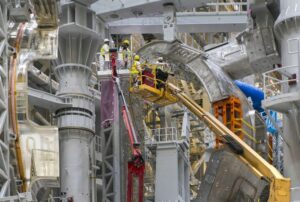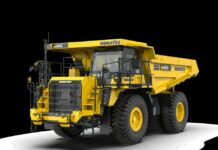Fusion, the process that powers all stars in the universe, holds the key to solving Earth’s growing energy crisis. The quest to achieve fusion has become one of the most significant technological endeavours of our time, writes Mathieu Kerbiguet, Regional Manager at Oqton.
It promises to generate vast amounts of carbon-free energy, addressing the mounting energy challenges we face today. However, achieving fusion is an enormous challenge. It naturally occurs at the core of stars like the Sun, requiring scientists to recreate those extreme conditions here on Earth. The forces, pressures, and temperatures necessary to push atoms together are mind-boggling.
To tackle this grand ambition, the International Thermonuclear Experimental Reactor Project (ITER) was established in 1985. This global initiative brought together 35 nations to prove the feasibility of fusion as a large-scale, carbon-free energy source.

In this article, we delve into the significance of nuclear fusion and how 3D scanning has played a vital role in this project’s development.
Understanding nuclear fusion
At the core of stars, including the Sun, nuclear fusion reactions occur billions of times per second. These reactions generate an immense amount of energy, capable of powering the Earth many times over.
Harnessing nuclear fusion here on Earth offers several advantages. Firstly, it provides a nearly limitless supply of energy without carbon emissions and with minimal nuclear waste. In contrast, traditional power plants rely on fossil fuels, nuclear fission, or renewable sources like wind and water. Nuclear fission produces radioactive waste that poses long-term storage challenges, sometimes spanning hundreds of years. In contrast, nuclear fusion produces less radioactive waste that decays more rapidly and eliminates the need for fossil fuels.
However, achieving fusion on Earth presents significant obstacles. Scientists must recreate the extreme conditions found in the center of the Sun, including the extraordinary forces, pressures, and temperatures required to fuse atoms together.
ITER’s approach to fusion
ITER’s approach to achieving fusion involves creating and controlling plasma, a state where gas is heated to incredibly high temperatures, causing electrons to separate from nuclei.
This plasma will be confined and controlled within a device called a tokamak, which employs powerful magnetic fields in the shape of a torus or doughnut. The completed tokamak is expected to produce 500 MW of fusion power.
Equipment and Nuclear SA (ENSA), a Spain-based company, has played a crucial role in designing the components that make up the tokamak vacuum vessel. Constructing this monumental device, which weighs 23,000 tons and measures 28 meters in diameter, necessitates precise engineering and cutting-edge technology.
To ensure the perfect alignment of the vacuum vessel’s nine sectors, ENSA employed 3D scanning and made-to-measure designs. The company used 3D scanning techniques, including photogrammetry and laser scanning, to capture detailed scans of the lateral edges of each sector. AsorCAD, an engineering specialist, also based in Spain, collaborated with ENSA and utilised Geomagic Design X from Oqton to convert the scanned data into editable 3D models.
Leveraging these geometries, ENSA’s engineering department developed custom splice plates and biscuits to connect and secure the different sections of the sectors. Once fabricated, the sectors will be welded together, marking a significant milestone in the construction of the tokamak.
Joseph Maria Sanchez, Technical Manager at AsorCAD, highlighted the benefits of Geomagic Design X for this project. He said: “Geomagic Design X is the most capable reverse engineering software for handling large point clouds, and the entire reverse engineering process is parameterised, allowing future corrections to be made more quickly. Considering the large size and high resolution of the point clouds we work with, the files we deal with are very large.
“In this particular project, 3D printing has assisted us in designing and manufacturing several tools necessary for conducting measurements with our Creaform 3D scanners. We have created tools to place dynamic references, necessary to guarantee design precision.
“We have also designed grips for using our 3D scanners with extensions, which helped minimise crane movements, as well as tools to expand the working capacity of our mobile tripod tracker, reducing the need for aerial platform movements.”
Transformative power of 3D technologies
The energy sector is embracing the power of 3D technologies, including 3D printing, 3D scanning, and 3D simulations. These cutting-edge tools offer numerous benefits, such as enhanced speed, efficiency, and accuracy, driving significant advancements in energy projects worldwide.
One key advantage is the cost-saving potential achieved through increased accuracy. Tools like Geomagic Design X leverage 3D scanning technology to identify potential flaws or misalignments in parts. By comparing the scanned data with the initial design, engineers can quickly identify areas requiring adjustment.
Without 3D scanning, extensive time and resources would be wasted on multiple iterations and molding attempts.
The reliance on 3D scanning and printing has significantly accelerated the completion of ambitious projects like ITER. Without these technologies, endeavours such as nuclear fusion would be exceedingly lengthy and costly.
Today, we have the capability to employ 3D technologies in almost every aspect of engineering, enabling the realisation of projects that were once unimaginable.
As technology continues to advance, data handling capabilities become increasingly important. State-of-the-art 3D software excels in acquiring and reverse engineering real-world data. Its intuitive functionality allows engineers to rely on accurate scanned data with ease, making modifications and optimisations for specific purposes, particularly within the fusion sector.
Antonio Sanchez, CEO of AsorCAD, concludes that “3D printing and 3D scanning have provided us with increased productivity by creating custom-made tools tailored to our needs, simplifying fieldwork,” contributing to the overall success of endeavours like ITER.
Future challenges for 3D scanning
While 3D scanning and printing have already revolutionized many industries, there are still challenges to overcome.
One key hurdle lies in making the technology more accessible and user-friendly. The complexity of using these tools often requires extensive training, limiting the number of skilled practitioners. Future developments, potentially powered by AI, could simplify the process and enable more individuals to leverage these technologies effectively.
Materials also pose an ongoing challenge. Extensive research and development efforts are devoted to finding the ideal materials that strike a balance between cost, constraints, and performance.
The continuous evolution of 3D printers and scanners, advanced 3D scanning software, and the emergence of hybrid materials, such as plastic-metal composites, are game-changers that offer greater cost-effectiveness and expanded capabilities.
As we look to the future, these technologies will only become more refined, empowering engineers and researchers to tackle grand challenges with unprecedented efficiency and creativity – no matter how complex.
















